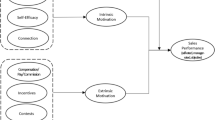Abstract
In their model of salesforce motivation and performance, Ford, Churchill, and Walker hypothesize that a salesman's selling experience, participation in his supervisor's decision making, and closeness with which he is supervised are negatively related to his perception of role ambiguity and positively related to his job satisfaction. In addition, they hypothesize that the salesman's perception of role ambiguity is negatively related to his job satisfaction. The present study supports these hypotheses in terms of the following findings: (1) participation and closeness of supervision were negatively related to the salesman's perception of role ambiguity, (2) closeness of supervision was positively related to his extrinsic job satisfaction, and (3) participation was positively related to intrinsic job satisfaction. Finally, role ambiguity was negatively related to both extrinsic and intrinsic job satisfaction.
Similar content being viewed by others
References
Adams, Stacy J. “Structure and Dynamics of Organizational Boundary Roles”, in Marvin D. Dunnette,Handbook of Industrial and Organizational Psychology. Chicago, Illinois: Rand McNally College Publishing Company, 1976, 1175–99.
Alderfer, Clayton P. and Benjamin Schneider. “On the Structure of Human Needs”, Working Paper, Yale University.
Churchill, Gilbert A., Jr., Neil M. Ford, and Orville C. Walker, Jr. “Organizational Climate and Job Satisfaction in the Salesforce”,Journal of Marketing Research, 13 (November 1976), 323–32.
Donnelly, James H., Jr. and John M. Ivancevich. “Role Clarity and the Salesman”,Journal of Marketing, 39 (January 1975), 71–4.
Fleshmann, Edwin A. “The Description of Supervisory Behavior”,Journal of Applied Psychology, 37 (February 1953), 1–6.
Griffin, Larry J. “Causal Modeling of Psychological Success in Work Organizations”,Academy of Management Journal, 20 (March 1977), 6–53.
Halpin, A. W. and B. J. Winer. “A Factorial Study of the Leader Behavior Description”, in R. M. Stagdill and A. E. Coons,Leader Behavior: Its Description and Measurement. Columbus, Ohio: Bureau of Business Research 1957.
Kahn, R. L., P. M. Wolfe, R. P. Quinn, J. D. Snoek, and R. H. Rosenthal.Organizational Stress. New York: John Wiley and Sons, Inc., 1964.
Kerlinger, Fred N. and Elazar J. Pedhazur.Multiple Regression in Behavioral Research. New York: Holt, Rinehart and Winston, Inc., 1973.
Korman, Abraham K. “Consideration, ‘Initiating Stucture’, and ‘Organizational Criteria’—A Review”,Personal Psychology, 19 (Winter, 1966), 349–61.
Likert, R.New Patterns of Management. New York: McGraw-Hill, Inc., 1961.
Nunnally, Jum C.Psychometric Theory. New York: McGraw-Hill, Inc., 1967.
Porter, Lyman W. “A Study in Perceived Need Satisfaction in Bottom and Middle Management Jobs”,Journal of Applied Psychology, 45 (February, 1961), 1–10.
Porter, Lyman W. and Edward E. Lawler.Managerial-Attitudes and Performance. Homewood, Illinois: Richard D. Irwin, Inc., 1968.
Rizo, John R., Robert J. House, and Sidney I. Lirtzman, “Role Conflict and Ambiguity in Complex Organizations”,Administrative Science Quarterly, 15 (June 1970), 150–63.
Schuler, Randall S., Ramon J. Aldag, and Arthur P. Brief. “Role Conflict and Ambiguity: A Scale Analysis”,Organizational Behavior and Human Performance, 20 (January 1977) 111–28.
Tosi, Henry, “Organizational Stress as a Moderator of the Relationship Between Influence and Role Responde”,Academy of Management Journal, 14 (March 1971), 7–20.
Vroom, V.Some Personality Determinants of the Effects of Participation. Englewood Cliffs, New Jersey: Prentice-Hall, 1963.
Walker, Orville C., Gilbert A. Churchill, Jr., and Neil M. Ford. “Motivation and Performance in Industrial Selling: Present Knowledge and Needed Research”,Journal of Marketing Research, 14 (May 1977), 156–68.
Walker, Orville C., Jr., Gilbert A. Churchill, Jr., and Neil M. Ford “Organizational Determinants of the Industrial Salesman's Role Conflict and Ambiguity”,Journal of Marketing, 39 (January 1975), 32–9.
Author information
Authors and Affiliations
Additional information
The author thanks Professor Norbert L. Enrick, Kent State University, for his useful comments on earlier drafts of this article.
Rights and permissions
About this article
Cite this article
Teas, R.K. An empirical test of linkages proposed in the walker, churchill, and ford model of salesforce motivation and performance. JAMS 8, 58–72 (1980). https://doi.org/10.1007/BF02721973
Issue Date:
DOI: https://doi.org/10.1007/BF02721973




